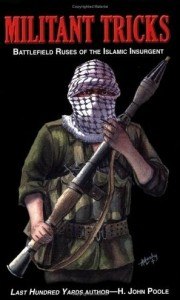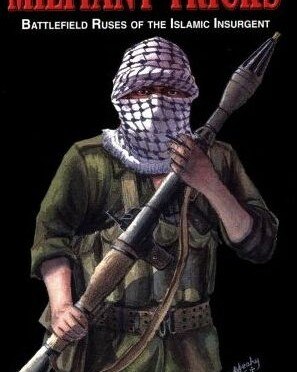 For anyone wanting a tactical analysis of the US military’s struggle with jihadis in painfully dry and wonky detail I can recommend Militant Tricks. Here follows my report of the book’s most salient points and some thoughts it inspired.
For anyone wanting a tactical analysis of the US military’s struggle with jihadis in painfully dry and wonky detail I can recommend Militant Tricks. Here follows my report of the book’s most salient points and some thoughts it inspired.
Amazon’s summary:
This book gauges America’s progress in Iraq and Afghanistan from a unique perspective—that of East-Asian battlefield deception. As both countries were part of the Mongol Empire for over 200 years, they are a perfect breeding ground for every sort of ancient Chinese trick—any one of the famous “36 Strategems.” In combination, those stratagems have the power to make a losing adversary think he is winning. They have done so before to America.
To see past the militant Muslim’s false face, one must look for the hidden intent behind his every initiative—whether martial or otherwise. Between September 2004 and September 2005, this book does just that for both theaters of war. For some readers, it will serve as an intelligence reference manual and be read a few paragraphs at a time. For others, it will provide an in-depth solution to the enemy’s so-far-successful formula and be read cover to cover. Militant Tricks reveals enemy information that active-duty Americans seldom see—that which is contained in the regional media and literature. When properly interpretted (by a student of Eastern tactics and mindset), that information may shed enough light on ongoing events to permit the salvaging of both wars.
While focusing mainly on events taking place in Iraq H. John Poole’s story weaves together lessons learned by the US military in Vietnam, Afghanistan, and Iraq, as well as the Israelis in Lebanon (1982-2000). After a hundred pages detailing incidents in Iraq and Afghanistan and another hundred reviewing these events in light of the 36 Stratagems the prognosis does not appear good:
Other Parts of the Joint Strategy
By early 2004, the Iraqi militants’ overall strategy had become clearly obvious: (1) curtail the flow of oil, (2) eliminate government-supplied social services, (3) isolate occupying forces, and (4) discredit/subvert local security forces. The first was done during commando raids. The second was accomplished with sabotage, assassination, and hostage taking. The third was achieved by using IEDs to limit the flow of supplies and tie occupying forces to thier vehicles or bunkers. The fourth was performed through repeatedly corruptiong or killing police and army personnel.
Something similar drove the Israelis out of Southern Lebanon and the Russians out of Afghanistan. Until someone finds a solution, this strategy will stalk the Third World.
Poole argues persuasively that Eastern-style “light infantry” are not in fact as inferior to US-style “heavy infantry” as so many Westerners in and outside the military seem to believe. The difference isn’t only one of weight, mechanization, or firepower. It is the tactics of Fourth Generation Warfare:
These techniques focus not so much on the enemy’s military capabilities (although these may be attacked) but directly against the will of the enemy to continue the war.
The crucial insight is that 4GW battlefields are not constrained to the time and space occupied by soldiers firing weapons. They include terrorism and sabotage. Fifth columns and mob violence. Peace demonstrations and elections. Jihadis have long recognized the value of dirty tricks. Mohammed himself ordered assassinations. Today’s jihadis will continue to exploit civilization’s gullible media, sleazy politics, and fragile economy as long as we let them.
“Shock and Awe” Is a Thing of the Past
In essence, the technologically deficient and financially strapped East has developed a style of warfare that requires no tanks or planes. It depends instead on surprise. That surprise is almost entirely based on the West’s preoccupation with firepower. To penetrate a Western base, the Easterner creates the impression of an indirect-fire attack. To blow up something within that base, he pretends to score a lucky mortar hit. The Muslim militant has taken this analogy one step farther. With the suicide bomber, he has created a precision munition.
The Vietnamese may have been financially strapped. The oil funded jihadis are not. They can buy any technology they need. They don’t use it for tanks and planes. Instead the jihadis leverage disruptive technologies – nets & jets, cell phones, TATP – to wreak destruction and chaos, to literally disrupt civilization. During and in the wake of the chaos they come to power, praising Allah’s greatness, posing as heroes.
Poole recommends that the US military train its own light infantry. Further, that this training should instill a more flexible doctrine of tactics, offensive and defensive, relying on stealth, deception, and surprise. Also that command should be more decentralized to enable smaller units to function more autonomously.
I’m afraid this won’t be enough. Until the ideology and history of jihad becomes better known amongst infidels the danger will go on, incompletely recognized and only partially countered.

